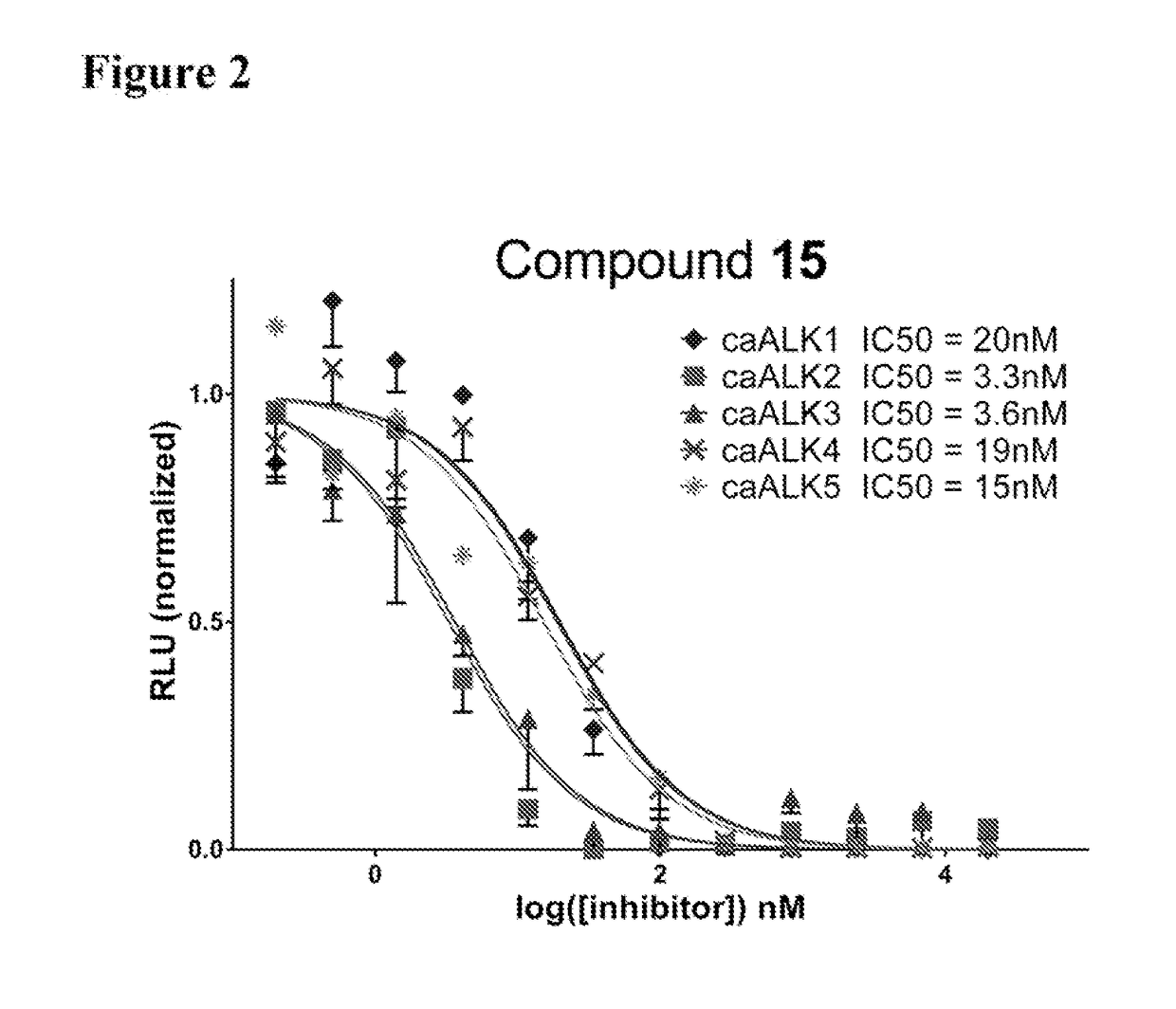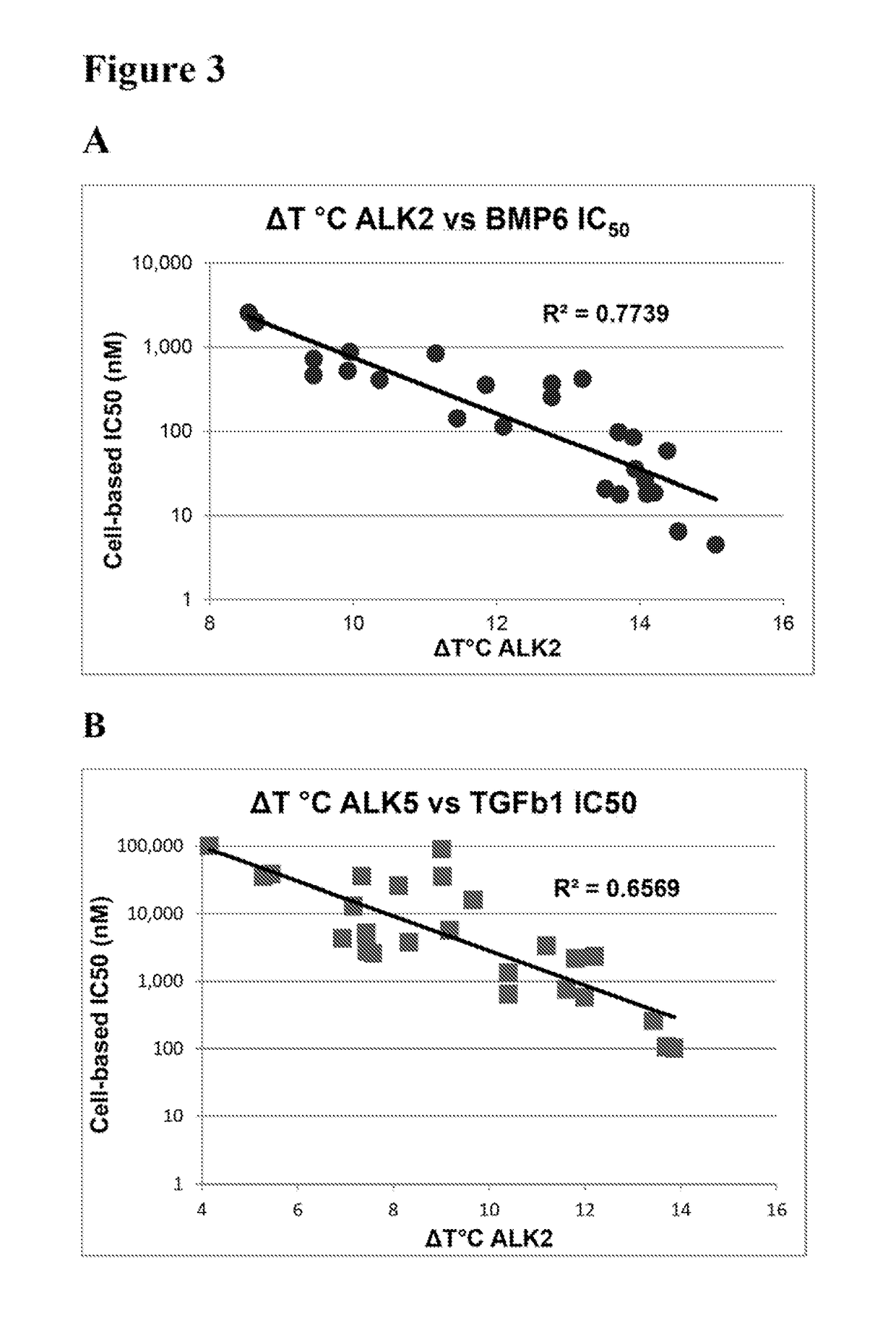Compositions and Methods for Inhibiting BMP
a technology of bmp and compound, which is applied in the direction of antibacterial agents, extracellular fluid disorders, and metabolic disorders, can solve the problems of limited specificity of ligand subclasses of endogenous inhibitors such as noggin and follistatin, and the structural diversity of this signaling system, so as to/or ldl and/or total cholesterol, reduce the risk of developing, and reduce the circulating levels of apob-100
- Summary
- Abstract
- Description
- Claims
- Application Information
AI Technical Summary
Benefits of technology
Problems solved by technology
Method used
Image
Examples
example 1
Protocols
Chemistry Material and Methods.
[0216]Unless otherwise noted, all reagents and solvents were purchased from commercial sources and used without further purification. The NMR spectra were obtained using a 300 or 500 MHz spectrometer. All 1H NMR spectra are reported in δ units (ppm) and were recorded in CDCl3 and referenced to the peak for tetramethylsilane (TMS) or in DMSO. Coupling constants (J) are reported in hertz. Column chromatography was performed utilizing a CombiFlash Sg 100c separation system with RediSep disposable silica gel columns. High-resolution mass spectra were obtained by using AccuTOF with a DART source. All test compounds reported in this manuscript had a purity ≧95% as determined by high-performance liquid chromatography (HPLC) analyses using an instrument equipped with a quaternary pump and a SB-C8 column (30×4.6 mm, 3.5 μm). UV absorption was monitored at λ=254 nm. The injection volume was 5 μL. HPLC gradient went from 5% acetonitrile / 95% water to 95% ...
example 2
ative Compounds
[0247]
TABLE 1Representative compoundsCompdStructureK02288a101112131415161718192021222324252627282930313233
example 3
[0248]Thermal melting experiments were performed using a Real Time PCR machine Mx3005p (Stratagene) with a protein concentration of 1-2 μM and 10 μM inhibitor as described by Niesen et al., Nat Protoc 2007, 2, 2212-21. Recombinant human kinases for DSF screening were prepared by SGC using the published methods of Sanvitale et al., PLoS One 2013, 8, e62721. The potency and selectivity of certain compounds of the invention based on thermal shift kinase and ligand induced transcriptional activity assays are shown in Table 2.
TABLE 2Thermal shift and cell-based signaling inhibition resultsALK2ALK5ALK2ALK5BMP6TGFβ1ΔTmΔTmIC50IC50IC50IC50Compound(° C.)(° C.)ΔTmDiff.(nM)(nM)(nM)(nM)Fold Select.K0228813.211.22.035280420 ± 1703,400 ± 500 81113.512.01.5ndnd20 ± 1 580 ± 50281213.912.21.7ndnd90 ± 302,300 ± 300 281314.413.40.9618060 ± 10260 ± 2041414.513.70.817496 ± 1110 ± 20171515.113.91.2101864 ± 1100 ± 10231611.57.24.3236,900.40 ± 30 13,100 ± 1,000921713.910.43.5141,00040 ± 106...
PUM
| Property | Measurement | Unit |
|---|---|---|
| weight | aaaaa | aaaaa |
| weight | aaaaa | aaaaa |
| weight | aaaaa | aaaaa |
Abstract
Description
Claims
Application Information
 Login to View More
Login to View More - R&D
- Intellectual Property
- Life Sciences
- Materials
- Tech Scout
- Unparalleled Data Quality
- Higher Quality Content
- 60% Fewer Hallucinations
Browse by: Latest US Patents, China's latest patents, Technical Efficacy Thesaurus, Application Domain, Technology Topic, Popular Technical Reports.
© 2025 PatSnap. All rights reserved.Legal|Privacy policy|Modern Slavery Act Transparency Statement|Sitemap|About US| Contact US: help@patsnap.com



